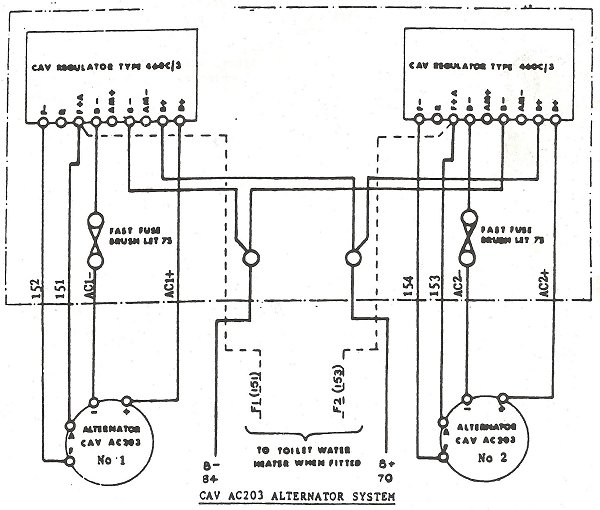Charging Systems
Operation of AC203 Battery Charging System
From a BR Training booklet
This system consists of the following equipment:
2 x CAV AC203 60 amp alternators
2 x CAV regulators type 460/C3
2 x fast fuses BLET.75
AC203 alternators rectify the generated alternating current electronically and this rectification is normally provided as a built in feature of this machine. Silicon diodes are used in this application.
The use of diodes in this application ensures that no adjustment for wear in service is required and this greatly reduces maintenance. All diodes have a safe voltage and current carrying capacity that the designer ensures is well above the system operating levels, but if this limit is exceeded then the diode may be irreperably damaged. Reverse polarity connections of the battery cause almost immediate destruction of the rectifier diodes.

The AC203 is a self-excited machine which differs from the AC8 alternator in that the rectifying diodes are built into the machine. The output is therefore D.C. which is fed to the regulator. The CAV 460C regulator is a solid-state unit sealed within an aluminium case. On Power Cars previously fitted with AC8 alternators, the regulators (and fast fuses) are housed in the same location as the displaced RUG unit. On Power Cars originally equipped with generators, the regulators are mounted in the box which occupied the Tonum regulator panel.
To prevent the alternator diodes being destroyed by reverse polarity connection of the vehicle battery, a 'fast' fuse is fitted to the NEGATIVE line from each alternator.
The regulator is set for a maximum voltage of:
29.5 Volts - Lead Acid Batteries
31.5 Volts - NIFE batteries

Dynamos (Generators)
Maintenance in preservation
Unmodified regulator settings
Modified regulator settings
Fault Finding and Maintenance
Stone's Leaflets:
A1002 - The Lamp Resistance
D1001 - Train Lighting Introduction
D1009 - Control Panel Description
E1016 - Panel, Enclosure - Open
E1018 - Panel, Totally Enclosed
P1002 - "Liliput" Regulator
P1006 - Tonum Control Panel
W1009 - Control Panel Diagrams
Alternators
Maintenance in preservation
In Introduction to Alternators
AC8 - Operation
AC8 - Maintenance & Fault Finding
AC8 - CAV Manual
AC8 - CAV Spares Parts List
AC8 - Schematic Diagram
AC14 - Schematic Diagram
AC203 - Description
AC203 - Operation
AC203 - Maintenance & Fault Finding
AC203 - Fault Finding - alternate
AC203 - CEPS 179 Overhaul Manual
CAV Rectifiers - Spare Parts
CAV460 Control Board
The Fast Fuse
FAQs on alternators


